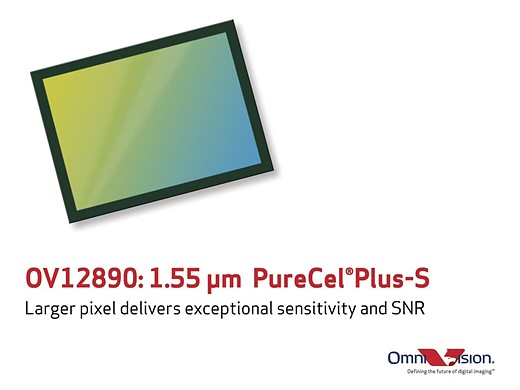New high-end camera sensor from OmniVision
OmniVision will soon be releasing OV12890, a 1/2.3″ 12MP sensor. This gives us 1.55μm (microns, 1/1000mm) pixel size. This sensor will be targeting the high-end mobile market.
Why does pixel size matter?
There are generally two camps when it comes to megapixels. One believes that more pixels is the best solution for image quality (IQ), regardless of low-light photography or not. The other believes that bigger pixels can significantly improve low-light IQ; the reason being that each pixel is receiving more good light, which provides a cleaner representation of the scene.
Not only pixel size is increased
The sensor on the OV12890 is also a bit bigger than we typically see in mobile phones. So OmniVision hasn’t just decreased pixels, they’ve increased sensor size as well, which also increases pixel-size.
A 1/2.3″ sensor is what we typically see in most consumer standalone compacts and super-zooms.

Who is OmniVision?
Sometimes mistakenly considered a generic sensor maker, OmniVision has been in the market for quite awhile– 1995 to be exact, though they didn’t start making mobile camera sensors until 2004. In 2015 OmniVision was acquired by Hua Capital Management, CITIC Capital Holdings and GoldStone Investment for 1.9 billion cash. We’re not talking about a little generic company here.
In fact OmniVision is the sensor maker behind many front-facing cameras in our China phones, and in major brand phones as well.
What about back cameras?
OmniVision isn’t limited to front-facing cameras, they also product very good sensors for rear cameras as well. The reason we don’t see them quite so much is because Sony and Samsung are much bigger. Panasonic has also recently been seen featured in several upcoming phones.
One company that took a chance recently with OmniVision rear cameras is the Motorola G Plus. The Moto G Plus featured OmniVision’s 1/2.4″ OV16860, which was rated highly by several photography sites, including dpreview, who had this to say: “In bright light the Moto G Plus 16MP camera module does a very good job at resolving detail. Thanks to very well balanced sharpening and noise reduction, fine textures and low contrast detail…”. This is coming from a site that generally deals with dSLR, so it can be considered high praise.
How do I know if I have an OmniVision sensor?
Assuming the manufacturer of your phone is forthcoming about specs, you will see “OV” proceeding the model number of the sensor.
A popular phone that recently used an OmniVision sensor is the Xiaomi Redmi Note 3 Pro, which uses OV5670.
OV16860 specs
| MegaPixels | 12 |
| Sensor size | 1/2.3" (6.17x4.55mm) |
| Camera module size | 10x10x6mm |
| Pixel size | 1.55μm |
| Continuous shooting speed | 12MP@45fps |
| 4K video speed | up to 60fps |
| 1080p (FHD) speed | up to 240fps (slo-mo) |
| Auto-focus | On-sensor phase-detect (PDAF) |
OV16860 boasts some aggressive specs, including some great continuous shooting mode numbers, impressive slow-mo, and phase-detection auto-focus (PDAF).
Don’t count OmniVision out as a generic or low-quality sensor maker– especially after the recent very expensive acquisition; we should see some vigorous forward momentum with their sensors being equal to higher-end Sony and Samsung sensors.
https://gizbeat.com/10345/new-high-end-camera-sensor-from-omnivision/https://gizbeat.com/wp-content/uploads/omnivision-450x338.jpeghttps://gizbeat.com/wp-content/uploads/omnivision-150x150.jpegNoteworthyOmniVisionPreviewsOmniVision will soon be releasing OV12890, a 1/2.3' 12MP sensor. This gives us 1.55μm (microns, 1/1000mm) pixel size. This sensor will be targeting the high-end mobile market. Why does pixel size matter? There are generally two camps when it comes to megapixels. One believes that more pixels is the best solution for...Damian Parsonshttps://plus.google.com/107879368390224447304 [email protected]AdministratorHi, I'm Damian Parsons. I've been working with Android phones since the first Droid came out. I'm fascinated by computers and technology. My first BBS were ran on an old Apple IIc and Commodore 64. I work hard to bring the latest updates to you every day - without all the boring fluff. Please subscribe to keep up on the newest China tech. See our forum -> www.chinaphonearena.comGizBeat





I have to say that I’ve always found the OV sensors on phones superior to the usual glut of Sony IMX214 et al that we always see. Really hoping over the next 12 months we see more phones utilising OV sensors.
I often enjoy the OmniVision sensors as well. They just don’t have as good a brand name as Sony / Panasonic / Samsung. So, usually the phone makers avoid them. As you suggest, let’s see if that trend will change.
Late to this thread. On the bottom, the spec sheet, isn’t this the spec for the new OV12890? I believe Omnivision nomenclature uses the first two digits to signify the megapixel count.